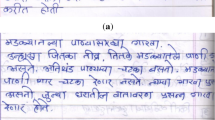Abstract
Recognition of Devanagari ancient handwritten character is an important task for resourceful contents' exploitation of the priceless information contained in them. There are numerous Devanagari ancient handwritten documents from fifteenth to the nineteenth century. This paper presents an optical character recognition system for the recognition of Devanagari ancient manuscripts. In this paper, improved recognition results for Devanagari ancient characters have been presented using the scale-invariant feature transform (SIFT) and Gabor filter feature extraction techniques. Support vector machine (SVM) classifier is used for the classification task in this work. For experimental results, a database consisting of 5484 samples of Devanagari characters was collected from various ancient manuscripts placed in libraries and museums. SIFT- and Gabor filter-based features are used to extract the properties of the handwritten Devanagari ancient characters for recognition. Principle component analysis is used to reduce the length of the feature vector for reducing training time of the model and to improve recognition accuracy. Recognition accuracy of 91.39% has been achieved using the proposed system based on tenfold cross-validation technique and poly-SVM classifier.











Similar content being viewed by others
References
Bhattacharya S, Kaluri R, Singh S, Alazab M, Tariq U (2020) A novel PCA-firefly based XGBoost classification model for intrusion detection in networks using GPU. Electronics 9(2):219
Caroro RA, Paredes R, Lumasag JM (2020) Rules for orthographic word parsing of the Philippines' cebuano-visayan language using context-free grammars. Int J Softw Sci Comput Intell 12:34–49
Daugman JG (1980) Two-dimensional spectral analysis of cortical receptive field profiles. Vis Res 20(10):847–856
Deng D, Chan KP, Yu Y (1994) Handwritten Chinese character recognition using spatial Gabor filters and self-organizing feature maps. Proc Int Conf Image Process 3:940–944
Dessai B, Patil A (2019). a deep learning approach for optical character recognition of handwritten Devanagari script. In: 2nd international conference on intelligent computing, instrumentation and control technologies (ICICICT), IEEE, vol 1, pp 1160–1165
Diem M and Sablatnig R (2010) Recognizing characters of ancient manuscripts. In: The proceedings of the international conference on computer image analysis in the study of art, pp 753106–753106
Gadekallu TR, Khare N, Bhattacharya S, Singh S, Reddy Maddikunta PK, Ra IH, Alazab M (2020) Early detection of diabetic retinopathy using PCA-firefly based deep learning model. Electronics 9(2):274
Helmer S and Lowe DG (2004) Object class recognition with many local features. In: Proceedings of the international conference on computer vision and pattern recognition workshop, pp 187–187
Khanderao MS, Ruikar S (2020) Character segmentation and recognition of indian devanagari script ICT Analysis and Applications. Springer, Singapore, pp 529–537
Lowe DG (2004) Distinctive image features from scale-invariant keypoints. Int J Comput Vision 60(2):91–110
Narang SR, Jindal MK, Sharma P (2018) Devanagari ancient character recognition using HOG and DCT features. In: Fifth IEEE international conference on parallel, distributed and grid computing (PDGC), Solan Himachal Pradesh, India, pp 215–220. doi: 10.1109/PDGC.2018.8745903
Narang SR, Jindal MK, Kumar M (2020) Ancient text recognition: a review. Artif Intell Rev. https://doi.org/10.1007/s10462-020-09827-4
Rani R, Dhir R, Lehal GS (2014) Gabor features based script identification of lines within a bilingual/trilingual document. Int J Adv Sci Technol 66:1–12
Reddy G, Kumar Reddy MP, Lakshmanna K, Kaluri R, Rajput DS, Srivastava G, Baker T (2020) Analysis of dimensionality reduction techniques on big data. IEEE Access 8:54776–54788
Sharma N, Patnaik T, Kumar B (2013) Recognition for handwritten English letters: a review. Int J Eng Innov Technol 2(7):318–321
Sharma R, Mudgal T (2019) Primitive feature-based optical character recognition of the Devanagari script. Progress in Advanced Computing and Intelligent Engineering. Springer, Singapore, pp 249–259
Sharma AK, Adhyaru DM, Zaveri TH (2020) A survey on devanagari character recognition. Smart systems and IoT: innovations in computing, Springer, Singapore, pp 429–437
Singh S, Aggarwal A, Dhir R (2012) Use of gabor filters for recognition of handwritten Gurmukhi character. Int J Adv Res Comput Sci Softw Eng 2(5):234–240
Trier OD, Jain AK, Taxt T (1996) Feature extraction methods for character recognition—a survey. J Pattern Recognit 29(4):641–642
Author information
Authors and Affiliations
Corresponding author
Ethics declarations
Conflict of interest
The authors declare that they have no conflict of interest. During our research, we suffered a lot from the lack of a public dataset. Thus, we don't have a benchmark to compare our algorithm with others. A public dataset may help other researchers working on similar projects as ours. So we decide to share our raw data for experimental work.
Additional information
Communicated by V. Loia.
Publisher's Note
Springer Nature remains neutral with regard to jurisdictional claims in published maps and institutional affiliations.
Rights and permissions
About this article
Cite this article
Narang, S.R., Jindal, M.K., Ahuja, S. et al. On the recognition of Devanagari ancient handwritten characters using SIFT and Gabor features. Soft Comput 24, 17279–17289 (2020). https://doi.org/10.1007/s00500-020-05018-z
Published:
Issue Date:
DOI: https://doi.org/10.1007/s00500-020-05018-z




